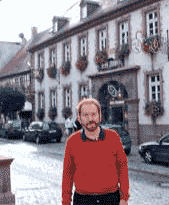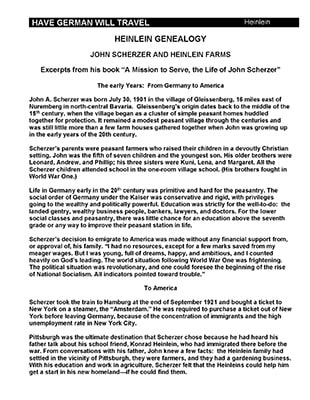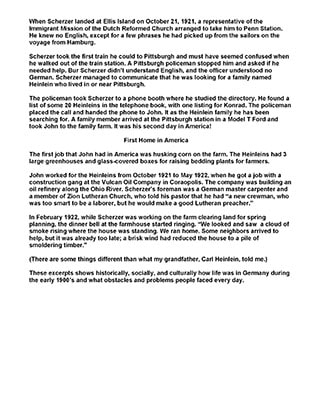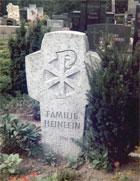Heinlein Genealogy
John Scherzer comments about Heinlein farms
Excerpts from his book "A Mission to Serve, the Life of John Scherzer"
The early Years: From Germany to America
John A. Scherzer was born July 30, 1901 in the village of Gleissenberg, 16 miles east of Nuremberg in north-central Bavaria. Gleissenberg’s origin dates back to the middle of the 15th century, when the village began as a cluster of simple peasant homes huddled together for protection. It remained a modest peasant village through the centuries and was still little more than a few farm houses gathered together when John was growing up in the early years of the 20th century.
Scherzer’s parents were peasant farmers who raised their children in a devoutly Christian setting. John was the fifth of seven children and the youngest son. His older brothers were Leonard, Andrew, and Phillip; his three sisters were Kuni, Lena, and Margaret. All the Scherzer children attended school in the one-room village school. (His brothers fought in World War One.)
Life in Germany early in the 20th century was primitive and hard for the peasantry. The social order of Germany under the Kaiser was conservative and rigid, with privileges going to the wealthy and politically powerful. Education was strictly for the well-to-do: the landed gentry, wealthy business people, bankers, lawyers, and doctors. For the lower social classes and peasantry, there was little chance for an education above the seventh grade or any way to improve their peasant station in life.
Scherzer’s decision to emigrate to America was made without any financial support from, or approval of, his family. I had no resources, except for a few marks saved from my meager wages. But I was young, full of dreams, happy, and ambitious, and I counted heavily on God’s leading. The world situation following World War One was frightening. The political situation was revolutionary, and one could foresee the beginning of the rise of National Socialism. All indicators pointed toward trouble.
To America
Scherzer took the train to Hamburg at the end of September 1921 and bought a ticket to New York on a steamer, the “Amsterdam.” He was required to purchase a ticket out of New York before leaving Germany, because of the concentration of immigrants and the high unemployment rate in New York City.
When Scherzer landed at Ellis Island on October 21, 1921, a representative of the Immigrant Mission of the Dutch Reformed Church arranged to take him to Penn Station. He knew no English, except for a few phrases he had picked up from the sailors on the voyage from Hamburg.
Scherzer took the first train he could to Pittsburgh and must have seemed confused when he walked out of the train station. A Pittsburgh policeman stopped him and asked if he needed help. Bur Scherzer didn’t understand English, and the officer understood no German. Scherzer managed to communicate that he was looking for a family named Heinlein who lived in or near Pittsburgh.
The policeman took Scherzer to a phone booth where he studied the directory. He found a list of some 20 Heinleins in the telephone book, with one listing for Konrad. The policeman placed the call and handed the phone to John. It as the Heinlein family he has been searching for. A family member arrived at the Pittsburgh station in a Model T Ford and took John to the family farm. It was his second day in America!
First Home in America
The first job that John had in America was husking corn on the farm. The Heinleins had 3 large greenhouses and glass-covered boxes for raising bedding plants for farmers.
John worked for the Heinleins from October 1921 to May 1922, when he got a job with a construction gang at the Vulcan Oil Company in Coraopolis. The company was building an oil refinery along the Ohio River. Scherzer’s foreman was a German master carpenter and a member of Zion Lutheran Church, who told his pastor that he had a new crewman, who was too smart to be a laborer, but he would make a good Lutheran preacher.
In February 1922, while Scherzer was working on the farm clearing land for spring planning, the dinner bell at the farmhouse started ringing. We looked and saw a cloud of smoke rising where the house was standing. We ran home. Some neighbors arrived to help, but it was already too late; a brisk wind had reduced the house to a pile of smoldering timber.
(There are some things different than what my grandfather, Carl Heinlein, told me.)
These excerpts show historically, socially, and culturally how life was in Germany during the early 1900’s and what obstacles and problems people faced every day.



